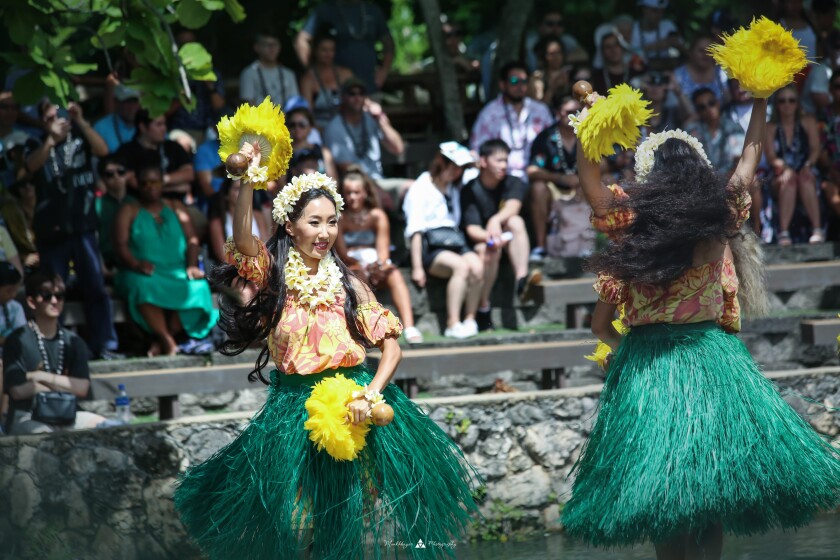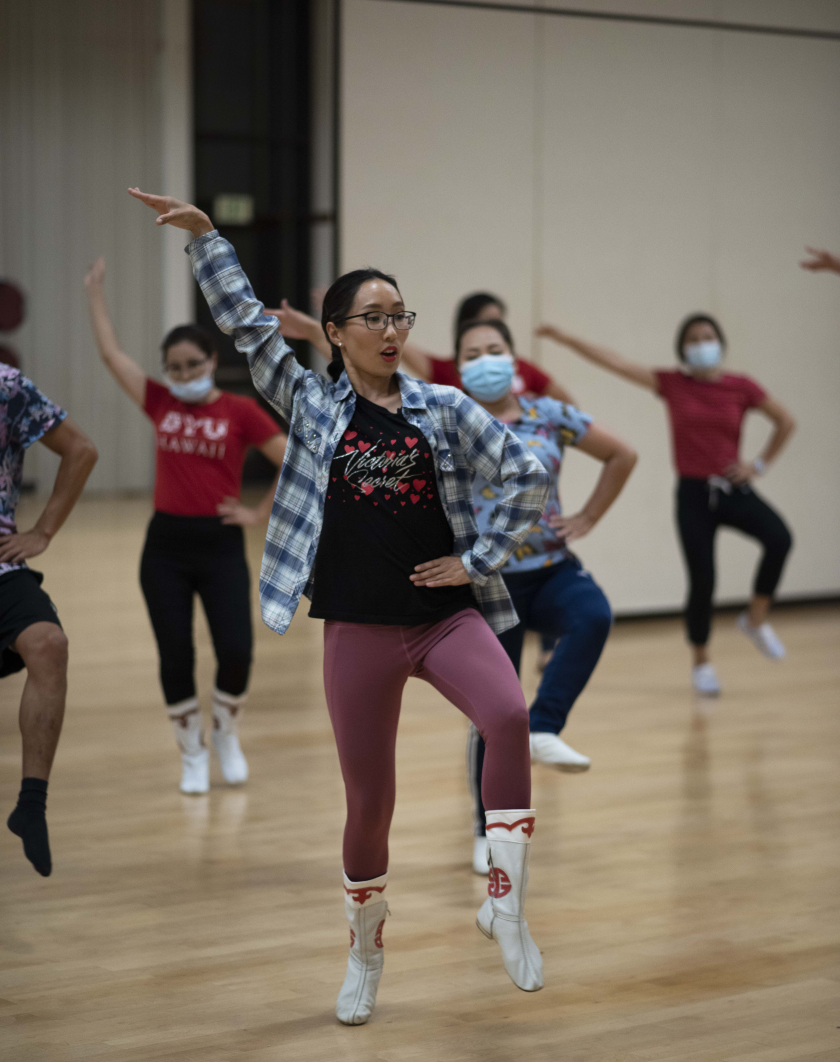
Narantsatsral Ganzorigt, a sophomore from Mongolia, said dancing at the Polynesian Cultural Center’s Huki show helped her learn about Polynesian cultures while helping her overcome her fear of dancing on water and screaming loud, “Cheehoos.” Her friends said she is a persistent, talented and soft-spoken person with a big heart.
Ganzorigt, an exercise and sport science major, said she got her bachelor’s degree in dance and choreography from the Mongolian National University of Cultures and Arts. While there, she said she earned many awards, including valedictorian. In 2013, she said she was deemed the best solo dancer in the Asia and Pacific Region Professional Dancer’s Competition held in Ulan Ude, Russia. In 2016, she won third place in the International Professional Dancer’s Competition in Seoul, Korea.
Before attending BYU–Hawaii, she said she worked at the Capital Ulaanbaatar Theatre as a dancer for four years. “I learned proper self-conduct on stage, [how to do] artistic makeup, wear costumes properly and many more things,” she commented.
Ganzorigt said what she learned there helped her as a professional and also as an individual. Because she usually worked with other professional dancers in a team, she said she learned to work with people and solve communication problems effectively.
She dances traditional Mongolian, Latin American, Polynesian, hip hop and modern dances. She said she likes to dance because it makes both the audience and dancer feel good.
Nomungerel Enkhtuvshin, a Fall 2020 graduate from Mongolia who majored in psychology, said Ganzorigt choreographed and taught the culture night performances for the Mongolian Club. Enkhtuvshin said she admired Ganzorigt’s willingness to bless others with her talent.
“She also can do many different types of dances,” she shared. “In one of my classes, I was required to do research on Stravinsky’s, ‘The Rite of Spring,’ which is a very dramatic, modern dance that requires a high level of professional skills. Ganzorigt performed it when she was working for the Ulaanbaatar theatre, and that was pretty impressive.”
First Mongolian Huki dancer
Being the first Mongolian to perform in the Huki show at the PCC, Ganzorigt said she is grateful for Uncle Jon Mariteragi for embracing her talent without discriminating.
“Uncle Jon told me I was the first Mongolian who danced at the canoe show. Even though I was the only Mongolian, and even the only Asian there, I never felt lonely,” she explained.
Ganzorigt said the Huki show is very unique and said she never expected to dance on a canoe in water. In the beginning, she said she had a fear of dancing on the water because it’s constantly moving.
“Uncle Jon showed me my first day video and it was very funny,” she explained. “I was trying to hide my fear, but my legs were not moving. Only my hands were dancing. But later, I overcame that fear and enjoyed dancing on canoes.”
Although dancing requires so much energy and effort, she said she still has enough energy to fulfill her obligations as a wife, a mother of three and a full-time student. “When I do my favorite job, it inspires me to have strength to do all my obligations and always be happy.”
After dancing for almost a year at the PCC, Ganzorigt said she changed her job because she got pregnant with her third child. However, she wants to dance at the Huki show when it starts again, she added.
Batbaatar Norjmaa, Ganzorigt’s husband and a sophomore from Mongolia majoring in information technology, said, “My wife is a very persistent person. She is a mother of three and always busy but never skips her dance practices. When she faces difficult dance movements or techniques, she practices until she masters them. I always admire her talent and persistence.”
Indigo Bopp, a sophomore from Laie majoring in political science, said she met Ganzorigt while working at Huki. “We often danced on the same canoes and walked together. She’s a hard worker and strives for perfection in all the dances she does. When she first joined, I could tell she was trying her best in practices.
“I witnessed how her Hula and Tahitian [dance] skills have grown dramatically over time. I am also amazed by how well she can mold herself into a new style of dance. I have many fond memories with her, but watching her grow and flourish within the dance culture is one of the best adventures I’ve been on with her,” Bopp shared.
Josephine Al-Angel Matafeo, a junior from Samoa majoring in accounting, said they became friends while taking dance classes. “She is an extremely talented dancer and a caring and mature mother,” Matafeo shared. “Tsatsa is confident in her decision making, considerate of different situations and adapts quickly.”
Matafeo said sometimes Ganzorigt brings her children to dance class and is able to multitask between practicing and taking care of her children. Matafeo said she stays flexible, skilled and healthy, despite her busy schedule. “All the memories I have of her are special because she inspires me as a dancer, a mother and a woman. She is an amazing person.”
Learning cultures through dancing

Ganzorigt said dance is a big part of many cultures because it is an artistic form of expression. “Dance is a language that helps people to understand each other. For example, PCC’s Hā: Breath of Life and Huki are not just entertaining shows, but they are also artistic expressions of historical stories.”
She said dancing at Huki helped her learn six different island nation’s cultures. “I learned that island lifestyles are very free spirited. When you are dancing, you can smile, scream and move freely.
“In Mongolian culture, we forbid yelling loud, so I rarely make loud noises. However, as a [Polynesian] dancer, I was required to scream ‘Cheehoo’ and it was tough for me.” She said she used to be afraid of screaming awkwardly or people making fun of her.
Ganzorigt said dance costumes tell a lot about the country’s climate and lifestyle. For example, most Mongolian dance costumes are fully covered and have hats and shoes, she said, while Polynesian dance clothes are more revealing because of the hot weather.
Dance movements, she said, also reflect the country’s social and religious rituals, people’s behaviors, natural phenomena, animals, daily chores and other cultural elements.
According to Ganzorigt, traditional Mongolian dances usually reflect herding livestock, making dairy products, Buddhist rituals and war preparations. She said, “For instance, shaking shoulders is a common movement in many Mongolian dances, which is imitating how we look when we ride a horse.”
On the other hand, she said many of the Polynesian dances represent ocean waves, breeze, aquatic animals, plants, warrior training and more.
Goals and dreams
Because exercise is an important part of being a dancer, Ganzorigt said she loves exercising and understanding physical movements on a scientific level. Because of these interests, she decided to study exercise and sport science.
After her graduation, she said she wants to blend dance and exercise and sport science in a program to help people have healthier lifestyles. Her goal is to use her knowledge and experience to help her people in Mongolia become healthier.
Ganzorigt said growing up in an artistic family ignited her passion for the arts, especially dancing. Her mother, Darisuren Dondov, is also a professional dancer who taught her to dance as a young child.
Her father, Ganzorigt Tserendondog, is a musician who plays piano, guitar, drums and the horse head fiddle, a traditional Mongolian music instrument. Her older sister, Naranchimeg Ganzorigt, is a professional singer, and her identical twin sister, Narantuya Ganzorigt, is a pianist, she added.
